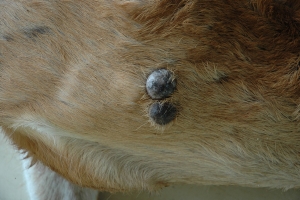Sick deer? Here is what to do.
Report Sick or Dead Deer of Unknown Causes to TWRA
If you have seen a deer that appears abnormally thin, exhibiting strange behavior, or has other anomalies that suggest the deer may be sick or diseased, please submit a report by clicking the button and entering pertinent information as prompted.
The purpose of these citizen reports is to help TWRA gauge disease and health issues that might affect the Tennessee deer population. Most reports will not necessitate an onsite visit by TWRA. TWRA staff cannot remove deer carcasses. If you need help with deer carcass removal, please contact the local city or county authorities. However, all reports are reviewed by a biologist to evaluate the severity of the circumstances. If the reviewing biologist determines an attempt for disease sampling is warranted and the contact information was included in the report, the biologist may contact the person who reported the sick deer for more information.
Reports that meet the criteria for a suspect Chronic Wasting Disease (CWD) case will be prioritized for sampling. For more information regarding CWD visit CWDinTN.com
Citizen reporting is incredibly beneficial in helping us with the early detection of disease and herd health monitoring. Please fill out all fields (at the link above) including location and, if possible, include high-quality photographs of the deer.
FAQ
There is a very skinny deer in my area. Does it have CWD?
Not necessarily, but please report it anyway (using the link above). CWD is not a disease that can be diagnosed just by looking at a deer. Skinny deer may have insufficient nutrition, an injury, or one of several common diseases known to afflict deer. However, if your report fits the criteria for a suspect case of CWD, we will do our very best to come to sample it.
Currently, CWD has only been found in southwest TN, but citizen reporting of sick deer will help ensure early detection should CWD spread or be introduced in other parts of the state. Early detection is critical to the effective management of the disease.
For the most up-to-date information on CWD in TN, please visit cwdintn.com
I found dead deer in (or near) a body of water. What should I do?
Please report it by clicking the link here (or above) and enter the information as prompted. This is likely a case of hemorrhagic disease (HD), which we do monitor.
HD is transmitted via a biting midge and is not transmissible to humans. While we are not able to get out and run definitive tests on every deer found dead, we do know that HD occurs frequently in Tennessee and is more common during warmer weather.
Besides CWD, HD is the most significant disease affecting deer in Tennessee. However, the biting midges that transmit the HD usually die during the first hard frost, and the severity of outbreaks varies annually and geographically.
We encourage reports of suspect HD so TWRA can monitor the disease’s impacts on deer populations.
There is an abandoned fawn. Does that mean it is sick? Should I report it?
TWRA does not need you to report sightings of fawns. Mother deer often leave their fawns alone in a place they feel is safe. Please leave the fawn alone. More than likely, the mother is nearby and will be back later in the day. Any attempts to aid the fawn could delay the mother's return.
Should I try and help deer that are sick or injured?
No, treatment of sick or injured deer is highly unsuccessful and dangerous to the deer and the person trying to help. The additional stress/injury on the animal precludes safe treatment and often makes matters worse.
Very few rehabilitators are able to work with deer. However, some are able to work with very young fawns. You can find more information here: https://www.tn.gov/twra/law-enforcement#rehabilitators
There is a deer with large black masses on it. What’s wrong with it?
The deer may have a large number of ticks, but it is most likely the deer has papillomas. This is a common skin condition of white-tailed deer and other Cervidae in North America. Papillomas are the equivalent of deer warts and they do not impact the meat of the animal. For monitoring purposes, we welcome reports of deer meeting these criteria.

